|
Box
presentation- The Tokyo Marui M1A2 Abrams arrived in a cardboard box with full color graphics, illustrations and
text in Japanese describing its function. As with most high-end Asian consumer products, presentation and package quality
is high. Removing the lid reveals a clear overlay over the tank itself, so it remains dust free should a store wish to display
it on a shelf. The tank model and transmitter is well protected with a styrofoam insert and cardboard overlay. Separate cardboard
boxes inside hold 6mm bbs and detail parts such as the Tank Commander and machine guns. Curiously
the styrofoam insert has a space for AA and 9 Volt batteries but none are included.
The instruction booklet is in a clear plastic pouch taped under the box lid. Also,
you will find two spring steel antennas under the tank when you remove it from the styrofoam box.
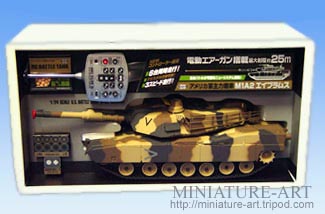
|
| The styrofoam readily protects the model |
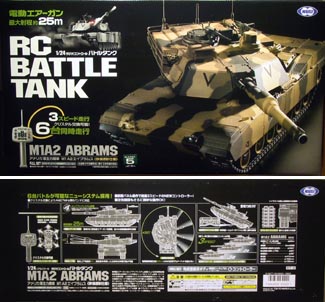
|
| Marui Abrams Box top and side describe the R/C function |
Painting
quality- Both versions of the M1A2 Abrams are painted, with a choice of overall standard Tan color, or 3 color
National Training Center (NTC) camouflage of tan, brown and black. The paint
applied is neat, with no messy overspray, trapped dust particles, and the pattern is accurate; although admittedly there are
many variations used at the NTC. All markings and stenciling are neatly painted on. Having accidentally run my tank into the
wall on numerous occasions I can say that the paints used are durable, and do not scratch off easily like hobby acrylic paints
would. There is no pre-applied weathering such as detail washes or airbrushed dust effects.
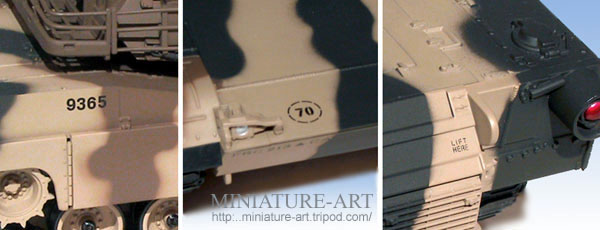
|
| The black stencils are sharp and clear |
Assembly
Quality- The hull, turret, and suspension arms are made of a dense ABS style plastic. All major assemblies are
screwed together. The hull is rigid and there is no body flex to its box-like structure. Molding quality again is high; the
one piece upper hull includes the side skirts for strength. They are not removable; unless you disassemble the hull and cut
the skirts segments off. Surface detail is very high, and comparable to Tamiya
and DML armor kits. Engine intake mesh pattern is crisp, weld seams are visible, and even the engine fire extinguisher handle
is included on the left hull side. Although faint, the upper turret and hull surfaces have the characteristic non-slip texture
of the actual tank. The front mud flaps are made of a soft rubber. On an off note, there is a seam on the main gun visible
where the two halves of gun were glued together.

|
| Tokyo Marui's M1A2 Abrams minus the detail accesories |

|
| Note the "V" shape tactical markings |
The dimensions of
the hull are accurate to the plans in Concord's
M1A1/M1A2 book, but the turret appears 11 scale inches too short. In real life terms, the turret should be lengthened by approximately
1/4 inch. This will be very difficult to do because the main gun, mantlet and Airsoft mechanism will have to be relocated
as well. The difference is slight and does not affect the function or appearance
of the tank at all.
Accesories-
The M2 50 cal. and M240 7.62 mm machine guns are pre-painted in a dark brown/gray color. The machine guns, towing hook, and
wire crew steps are supplied on two sprues. Small ejector pin marks are visible on the surface of both machine guns. You will
need to touch up the paint when you cut these items off the sprue. They appear to be made from a nylon based plastic and will
bend before breaking if accidentally twisted.

The Tank Commander (TC) figurine
is nicely sculpted, and fits in the hatch with a peg. Painting quality is basic, there is no shading or highlighting,
and the face is blank without eyes painted in. Both arms are articulated at the shoulder, and the figurine can be posed to
look with binoculars. A mold seam separates the Tank Commander, front and back.
Hull
Interior- Opening the hull may void the Japanese warranty, but for the curious, this is what you will find: The main gearbox is located in the rear of the hull, behind another compartment that
holds 8 AA size batteries. The front of the hull holds a circuit board that controls the functions of the tank. It is covered
by a plastic cover as well, although the hull is by no means weather/waterproof.
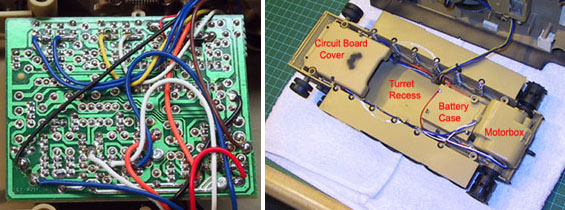
|
| Close up of the circuit board, and hull interior |
There are two large Mabuchi
motors in the gearbox (size 280), one to drive each track. I'm not experienced with radio control gearboxes but from my observation,
the motors have various gears attached, presumably reduction gears, and are connected by a toothed central shaft. All gears
are covered with thick white grease. The central drive shaft equalizes power distribution, during forward motion. When the
tank makes a turn, one motor continues to run while the other is stationary. The central drive shaft is split in the middle
with a toothed profile, thus allowing one motor to run while the other is off for right or left hand turns. This toothed central drive shaft is responsible for the loud gear noises emanating from the tank during
turns.
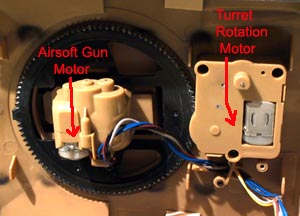
|
| Turret motors are 130 size Mabuchi units |
Another
smaller gearbox (size 130) is attached to the upper hull for turret rotation, and two others are inside the turret for
main gun elevation and firing. Turret rotation and gun elevation is smooth, but all motors are quite audible while in
operation. It's not a quiet tank to operate!
(Note- The Mabuchi
motors are high quality items that use carbon brushes)
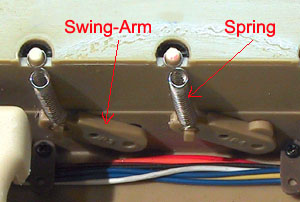
|
| Suspension swing-arms |
Suspension-
There are 7 suspension arms with road wheels screwed in. Unlike the real Abrams tank which used a torsion bar system, the
model has separate (independent) swing-arms inside the hull to save space, each with a spring attached. The suspension allows
approximately 1/2 inch travel and is quite tight; there is no track tension adjustment to the front idler wheels. The springs
used on the suspension arms are of two different diameters. The ones found in the rear of the tank are the thicker, high
tension variety to account for the weight of the gearbox and batteries. The others use a thinner, lower tension
spring.
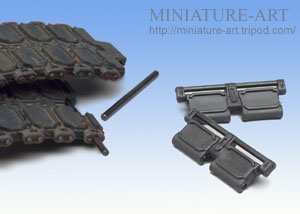
|
| The original rubber treads left, replacement links right |
Tracks- The
tracks installed on the tank are full length (rubber band style), all rubber items, and similar to old plastic model kits.
Each track is divided into two segments held in place with a steel pin. Traction is very good, the rubber is dense, and will
not shed easily, and the tank can climb up the smooth glass incline of my car's windshield.
Tokyo Marui also produces a replacement track made of individual plastic segments. They are assembled by snapping the
segments together, and are strong enough to stay in place when the tank is being played with. This is a highly recommended
item; since it results in less tension and wear on the gearbox. It also allows faster forward speeds at the expense of traction.
They work fine for use on sidewalks, carpet and in grass and dirt. Both rubber and plastic tracks are sufficiently stiff;
I have yet to throw a track on manuvers.
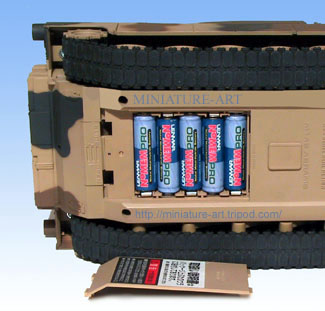
|
| Battery compartment, hull bottom |
Batteries- The tank operates on 8 AA size batteries located in a compartment in the bottom of the rear hull.
The battery cover has two wide pegs and is held in place with a spring activated switch, so it will not accidentally fall
off during play. I current use 23mh Nickel Metal Hydride (NiMh) batteries, allowing me an average of 2 hours of continuous
operations. NiMh batteries do not exhibit the "memory effect" like Ni-Cad batteries. A fast battery recharger is recommended
as well.
The battery compartment and the on/off switch
is not sealed, thus you should not run the tank in water or snow.
To continue, click
on the link below:
Review Page 2
|

